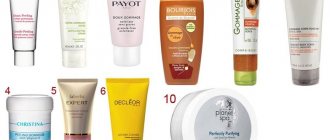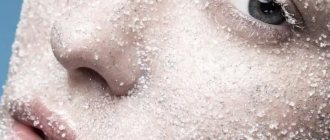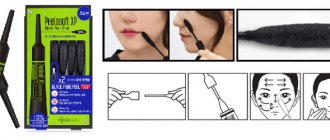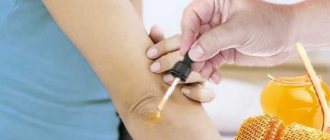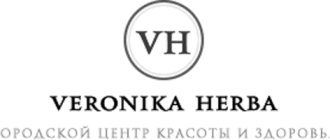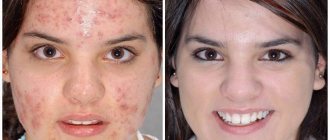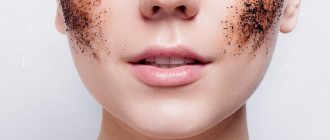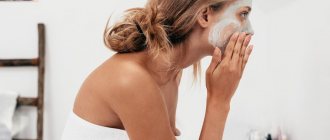Daily washing is very important for the surface layer of the skin, as it cleanses the epidermis of dust, dirt, bacteria and sweat secretions. But this is not enough for deep cleansing, so it is recommended to use special products - gel peelings for the face - 1-2 times a week.
In addition to the cleansing function, they remove dead skin particles and prevent inflammatory processes (in particular, due to clogged pores). What components are included in gel peels and how to use them correctly at home? To whom are peeling products indicated primarily and in what cases are they contraindicated for use?
— Is it possible to do chemical peeling at home?
— Cosmetologists, as a rule, do not recommend doing home facial peeling using chemicals, because they often encounter complications that patients receive as a result of such amateur activities. Manufacturers of cosmetics, on the contrary, promote their products and convince them that chemical peeling is possible at home.
I think that chemical peeling can be done at home only if several conditions are met:
- home facial peeling should be gentle and superficial (you can only use AHA peels - an alpha-hydroxy acid group of peels in the form of a gel or foam);
- instructions for using peeling must be strictly followed;
- two weeks before peeling, you should not use other abrasive or invasive techniques, medications or cosmetics that affect skin permeability.
Indications and contraindications for use
Gel peels are indicated for use in the following cases::
- with early skin aging;
- in the presence of “bags” and bruises in the lower eyelids;
- with an unhealthy complexion (yellowish, gray, sallow);
- in the presence of marks and spots from acne;
- in case of acne (without obvious signs of purulent inflammation) and blackheads;
- with shallow pigmentation;
- in case of dry and flaky skin;
- in the presence of small facial wrinkles;
- with increased fat content.
Gel peels are contraindicated in the following cases::
- in case of individual intolerance to chemical or natural components in the composition of the product;
- during pregnancy (because due to unstable hormonal levels they can cause pigmentation);
- in case of active herpes with all accompanying symptoms (rash in the form of blisters, burning, itching);
- in the presence of wounds and abrasions on the face;
- for purulent rashes (since peeling can aggravate the situation, causing bleeding and the spread of infection);
- for sunburn.
Note! Gel peels should be used with extreme caution in the presence of rosacea (impaired blood circulation in the superficial layers of the skin, manifested in the form of spider veins). In such cases, it is advisable to contact a cosmetologist - a specialist will help you choose a gentle peeling product.
— That is, you do not recommend doing medium and deep types of peeling at home?
- I absolutely do not recommend it. If the product is intended for superficial peeling, it means that it will act exclusively in the upper, stratum corneum layer of the skin; accordingly, even if something goes wrong, the risk of side effects is very small. Superficial home facial peeling does not require a rehabilitation period - everything goes unnoticed, after which only slight peeling of the skin is possible.
Medium peeling acts down to the basal layer of the skin, and deep peeling completely destroys the basal layer and affects the dermis. Medium and deep peels are not always easy to apply, and most importantly, they have a rehabilitation period that can only be carried out under the supervision of a doctor. Some types of deep peeling can only be performed by plastic surgeons and only in specialized medical institutions!
What compounds are used
Preparations for peeling are selected individually depending on the characteristics of the skin and its condition. The higher the acid concentration, the more effective the effect, and the less suitable this option is for delicate, sensitive skin. Different types of acids also differ greatly from each other. Depending on the size of the molecules and the depth of penetration, they can act more or less delicately, which means they are suitable for different skin types.
The most popular types of chemical peels:
- Almond. This is a superficial peeling based on mandelic acid, which has an exfoliating, moisturizing, and antiseptic effect. Due to its large size, the mandelic acid molecule penetrates shallowly into the skin and acts very gently. Almond peels do not increase photosensitivity and can be used all year round. Finally, it is an optimal choice for problematic, impure skin, as mandelic acid prevents the formation of comedones and clears out crusts. The course consists of 6-10 procedures;
- Pyruvic (summer). Another gentle option for year-round use. This superficial peeling uses pyruvic and lactic acids, which stimulate cell regeneration, moisturize the epidermis and tighten pores. The procedure is suitable for dry and sensitive skin;
- Yellow. Retinoic acid, which can be used for both superficial and mid-level peels, has a rich yellow tint, which gives the procedure its name. It must be borne in mind that after such exposure the epidermis also acquires a yellowish tint for some time. The acid penetrates deeply into the dermis and triggers regeneration processes. This is a good choice at the first signs of aging, since the procedure has a pronounced rejuvenating effect, and also tightens the skin, gives it elasticity, and regulates the functioning of the sebaceous glands. Like other medium peels, it requires special preparation;
- Biophytopilling. This is a superficial peeling based on hydroxyl acids, supplemented with plant extracts and vitamins. The procedure instantly improves the condition of the skin and complexion, gives the epidermis elasticity and smoothness. Biophytopilling is carried out in courses and is suitable for any skin except very dry skin;
- Melaspil. The drug contains salicylic and hydroxypropionic acids, as well as resorcinol and depigmenting agents. Medium peeling is optimal for combating hyperpigmentation; it perfectly whitens, rejuvenates the skin and improves its condition. Not suitable for dark skinned people;
- PRX-T33. This product is specially designed for sensitive and dry skin. After the procedure, there is no peeling of the skin, but the dermis is intensively renewed under the influence of trichloroacetic acid TCA, kojic acid and peroxide;
- Trichloroacetic. This option is famous for the fact that it effectively tightens enlarged pores, improves complexion, and eliminates signs of photo- and chronoaging;
- Jessner peeling. Mid-surface version based on salicylic and lactic acids with resorcinol. Recommended for oily or aging skin. Depending on the number of layers applied to the face, it is used as a surface or middle layer;
- Salipil (anti-acne). A drug based on salicylic acid is used, has a pronounced anti-inflammatory effect and helps fight rashes. Also suitable for mature skin;
- Depigmenting. As the name suggests, this variety is designed to combat hyperpigmentation. For such peels, various acids can be used alone or in different combinations. Whitens and rejuvenates, gives freshness and matteness;
- Fruit. In this case, fruit acids are used. Depending on the concentration, they have a gentle or more intense effect on the epidermis. Suitable for any age, especially effective at the first signs of aging. A good choice for problematic, rash-prone skin;
- Glycolic. The acid contained in green grapes and sugar cane is used. Due to its low molecular weight, it penetrates well into the skin and has an effective effect. Suitable for refreshing all skin types, smoothes out fine wrinkles, tightens pores and eliminates pigmentation well;
- Lactic. In this case, the acid contained in fermented milk products, as well as blueberries, tomato juice, grapes, and apples is used. It has a pronounced exfoliating and moisturizing effect.
The cosmetologist selects the appropriate option depending on the condition of the epidermis and existing defects.
— What complications can arise after peeling at home and how to deal with them?
— There can be a lot of complications, but encountering them can be avoided if you pay attention to the indications and contraindications for the use of cosmetics intended specifically for home use.
And, I repeat, strictly follow the instructions. Unfortunately, many patients tend to violate the rules of use - for example, leave the product on longer, instead of the recommended 10 minutes, leave it for the entire 15 - “so that there is definitely an effect.” As a result, the effect will not increase, but, on the contrary, unforeseen problems will arise. If the instructions say “if you feel a burning sensation, remove the product immediately,” then you should not ignore this warning and stoically endure until the last. You should not take such liberties during home peeling.
There is no need to eliminate complications on your own; it is better to consult a doctor immediately. The most common complication after peeling is pigmentation, which you have to put up with for several weeks or months. Pigmentation occurs, among other things, due to non-compliance with the rules of post-peeling care.
Effect
After a course of procedures, the face becomes fresh and youthful. Peels are very popular precisely because the results are clearly visible. It can be appreciated not only by attentive observers - even casual acquaintances will notice a clear improvement in the condition of the skin.
Compliments are guaranteed after the first sessions, and by the end of the course:
- Improves and evens out complexion;
- Wrinkles are smoothed out and disappear;
- Elasticity and turgor increase;
- Pigmentation disappears;
- The skin becomes smooth and soft;
- Acne goes away;
- Scars are smoothed out, incl. from post-acne;
- Pores tighten;
- The functioning of the sebaceous glands is normalized.
Peeling courses combine well with other cosmetic procedures - both hardware and injection. A cosmetologist will tell you how best to combine different types of treatment to achieve optimal results.
— How to properly care for your skin after home peeling?
— Post-peeling care is very important. After all, in the process of exfoliation you removed the upper stratum corneum of the skin and stimulated the dermis, as a result the skin becomes more vulnerable and sensitive to the sun's rays. After peeling, you should not do any other aggressive procedures.
It is very important after peeling the skin to take care of its protection from the sun. The use of sunscreen after any peeling, both medical and home, is mandatory!
After peeling at home, it is necessary to take both immediate (immediately after the procedure) and rehabilitation measures (starting from the second day after the procedure). Immediate post-peel care is aimed at reducing the inflammatory reaction, and the rehabilitator should create comfort for the skin (using moisturizing creams, for example, with vitamin E, and sunscreen).
Rehabilitation
After chemical peels, you need to take good care of your skin to give it a chance to recover. First of all, hydration is necessary. It is recommended to use products with hyaluronic acid, panthenol, aloe and vitamins. In addition, you should avoid any aggressive procedures, the use of alcohol-containing cosmetics, retinoids, and mechanical scrubs. When crusts appear, you cannot remove them yourself - you should be patient and wait until they fall off spontaneously.
It is extremely important to protect your face from ultraviolet radiation. The renewed epidermis is especially sensitive to such effects, so the risk of age spots increases. So the use of protective lotions with a high SPF factor is mandatory not only in the summer (when peeling is generally not recommended), but also in the winter.
To maintain the effect, your doctor may recommend using special cosmetics containing acids. They can be included in creams for everyday use in low concentrations sufficient to preserve the results for a long time.
After superficial treatment, the skin is restored quickly, however, during the entire course and two weeks after its completion, careful care and avoidance of any aggressive influence are necessary.
Recovery period
The duration of recovery after the procedure depends on the depth of acid exposure. So, after superficial peeling, recovery will take several days, after medium peeling – up to 14 days. Skin regeneration processes after deep peeling require more time - up to six months.
Regardless of the type of peeling and the duration of the recovery period, it is important to take care of your facial skin and follow your doctor’s recommendations. There are few restrictions during this period, but it is highly advisable to comply with them; first of all, it is to refrain from visiting the bathhouse, sauna and, of course, the solarium. Protecting the skin from ultraviolet rays, even in winter, is also the main rule during the recovery period. It is recommended to drink plenty of fluids and touch your face as little as possible.
In addition to generally accepted restrictions, there may be individual ones, which are prescribed by a cosmetologist. A professional specialist will also give recommendations on the use of skincare and decorative cosmetics during the recovery period after the procedure.
